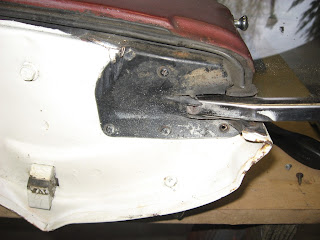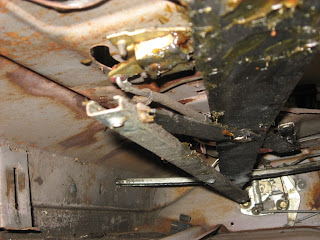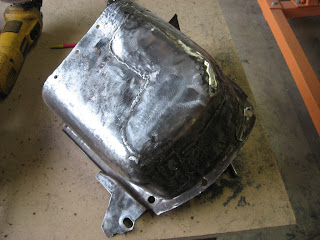Like the fenders, the doors were out under a tarp and were also in need of attention. I want to have them stripped and repainted with the rest of the car, of course. However, before I could do anything with them, they needed to be broken down to the shells. This is to protect the glass as well as to open up my options about how to strip and/or mend them. Not only that but the guts add considerable weight to the doors making them very heavy and cumbersom to move and work on.
Here's how they sat for the past 3 years.
I'm going to go through the disassembly of a door step by step. My best pictures are of the passenger side but the first few pics are of the drivers side door so don't let that trip you up. Here's the business side of the door. The majority of disassembly involves this side but first we have to get past the arm rest, door handle, and window crank.
Those two holes in the top of the arm rest give access to two 3/8" screws. Remove those and the arm rest pops off. The door latch handle and window crank are both held on by one philips machine screw. Remove them and you're rewarded with this.
The door panel itself is held on by 16 clips that can be popped by a flat screwdriver or such using upward pressure. I found that I needed to keep the tool right at the clip to keep the clip from ripping out of the cardboard backing of the door panel.
Beneath the door panel is a vapor barrier. It's held in place by a soft, gooey seam sealer. It's just made of paper with a slick backing so it's easy to rip through if your not careful. I used a putty knife to scrape it away from the door as carefully as possible.
Here's the vapor barrier when removed as viewed from the inside surface. I'm not sure what the backing is. Possibly a thin plastic membrane? It might just be paint too.
Here's the door ready for tear-down. Something interesting about how the doors were painted. It looks like the primary exterior color was applied to the entire door and then the interior color was sprayed just around the outside edges. If you're going to color-match your interior paint for originality, this is a good place to see a sample of perfect interior paint.
I chose to start my work by first removing the window from the three screws holding it onto the regulator channel. For such little things, these three screws were a bear to remove. I think between the 6 screws removed from both doors, I saved two screws total. The others had to be removed by an extractor. The arrows in the picture below show the location of the screws. The window has to be in this position to access them.
Note: From here on out, I'll have several such pictures with arrows in them. Click the pictures to zoom the image.
There are several window stops that need to be removed. The first is shown in the picture below. The small sheet metal part to the left of the hole with the screw in it was removed from the opening to it's right. The part went on the other side of the window base mounting plate (the metal part seen through the hole) and the small bolt held it on.
The rubber seal on the latch end of the door must be removed to access some other important bolts to be removed. It's just held on my five small philips screws.
Beneath that seal you see the two bolts with the arrows pointing at them. The one on the left holds a window stop that need to be removed. The one on the right holds the right-side window channel up against the inside panel of the door. This has to be removed to allow the channel to flop down so the window can be pulled out.
See that black strip of the tape on the right side of the door panel? That has to be removed.
After removing the tape, you can access the third and last window stop (the top-right arrow). Remove the bolt and the window stop block will drop down into the door where you can fish it out. This also might be a good time to remove the second window channel support nut (the lower left arrow). You can see this nut in place in the above picture.
Now, before the window can actually be removed, the side wing window needs to be removed first to allow the main window to move all the way up the left side channel. The wing window is removed by removing the two bolts at the top arrows and the two adjusting nuts at the lower arrows.

The wing window assembly actually contains the left side main window channel. Just moving this assembly to the left should allow enough clearance for the main window to be removed. To completely remove the wing window, the two adjusting studs (lower arrows above) need to be dropped down and the whole assembly positioned such that the adjusting studs can be unscrewed from the frame with a hex driver to allow the frame assembly to be slid upwards out of the door. Now that all of these parts are out of the way, the main window should come up out of the door with a little effort. I found that removing the top, fuzzy window seal in the window opening allowed more clearance for the channel rollers attached to the window mounting brackets to pass through the window opening. Remember to allow the right-side window channel to drop down away from the inside panel and allow the rollers to clear the window opening.
This is what the window looks like when removed.
Now removing the regulator mechanism is easy-breazy. Just remove the four bolts indicated by the arrows below.
Here's a shot of the regulator from inside the door. The long channel on the left is attached to the lower window mounting bracket. You can see the skinny arm on the far right (back) of the picture is inserted into the short channel mentioned above.
There's an arm on the regulator with a roller that inserts into the small channel seen above. When you remove the regulator, slide that arm back and it will drop out of the channel. You can then snake the regulator assembly out of the large access hole.
You can then remove the small channel by removing the two nuts at the locations indicated by arrows in the below picture.
The door seal rubber can just be pulled away from the door. It helps to work along it with a putty knife. Also, there's a hard section at both ends of the seal. One uses two small rubber plugs inserted into holes near where the seal contacts the side wing window and the other is a hard strip glued to the door above seal that covered the right-side channel mounting bolts (see the 10th image from the top of this post).
Here's the removed seal.
There are two weather strips attached to the inside of the window opening in the door. The inside one is fuzzy and the outside one is flat rubber. They are both held on with clips that insert through the holes indicated by arrows in the picture below. These are a real pain to remove. I had to slide a scraper blade between the seal and door next to each clip and rock the tool downward hard to pop them. A guy more experienced with trim than me would likely have a much easier time. By the way, the fuzzy inside seal is the one that may have to be removed prior to getting the window out.
The hinges can pretty much be removed any time but I did them here. Just six bolts that are screwed into moveable plates captured inside the door.
Here's what the removed hinges look like. The rust under each hinge also kind of gives us insight into how the cars were painted. With doors on.
Now the best for last. The removal of the door latch/lock mechanisms. I started with the outside door handle. To get it off, I first had to remove the latch pull-rod. All latch rods are removed the same way, by popping the clip indicated by the arrow away from the rod and then lifting the rods 90 degree bend out of its hole. The lower arrow is pointing at one of the door handle mounting screws. Remove that one and a single 3/8" nut inside the door and the door handle is removed.
Here's a shot of the removed door handle. Like the overspray from the prior "restoration"? Maaco anyone?
From the inside of the door, you can see the door latch in the middle with a rod running toward the top of the picture to the inside door handle. The rod at the top that runs to the right goes to the door lock knob. The short rod that runs from the lower left side of the latch to the lower right side of the door goes to the door key lock and the rod from the lower right side of the latch goes to the outside door handle.
To remove the inside door latch, the rod clip can be accessed by rotating the spindle a few degrees. Pop it open and remove the rod from the inside door handle mechanism. Remove the three screws indicated by the red arrows after removing the handle from the spindle, and the mechanism drops down into the door.
To remove the door key lock, remove the clip indicated by the red arrow to the right and remove the rod from the hole. Next use pliers to pull the retainer clip indicated by the arrow on the left straight towards you and the lock mechanism will drop out of the door with the rod attached to it.
Here's the removed lock and clip.
Finally, the latch assembly can be removed. Just take out the three philips screws indicated by the arrows below and the mechanism drops into the inside of the door.
Here's the various latch, handle, and lock mechanisms as one assembly.
In the bottom of the door, there's a big rubber stopper that stops the window just about where the top of the window is level with the door opening.
Here's the completely disassembled door from the outside.
And a shot from the inside.
The other door was disassembled the same way. Now I just need to decide whether to media blast the door shells or have them dipped.
Here's a handy image that I found on the interwebs that might help in with the positions of the various parts:
Dipping:
- Would clean the inside and outside surfaces of the shells and will not damage the texturing on the interior panels
- May leach out after painting and damage the paint.
- Twice as expensive as media blast
- Possibility of "cooking" the chemical out of the seams with a torch
Media Blast:
- Walnut shells are unlikely to damage the texture but could still be risky.
- Can't clean the inside surfaces of the shells leaving rust to do its job
- Half the price of dipping
- Leaves a mess of media in the doors that would have to be cleaned out.
- Possibility of treating the inner surfaces with Ospho and ZeroRust.











































































